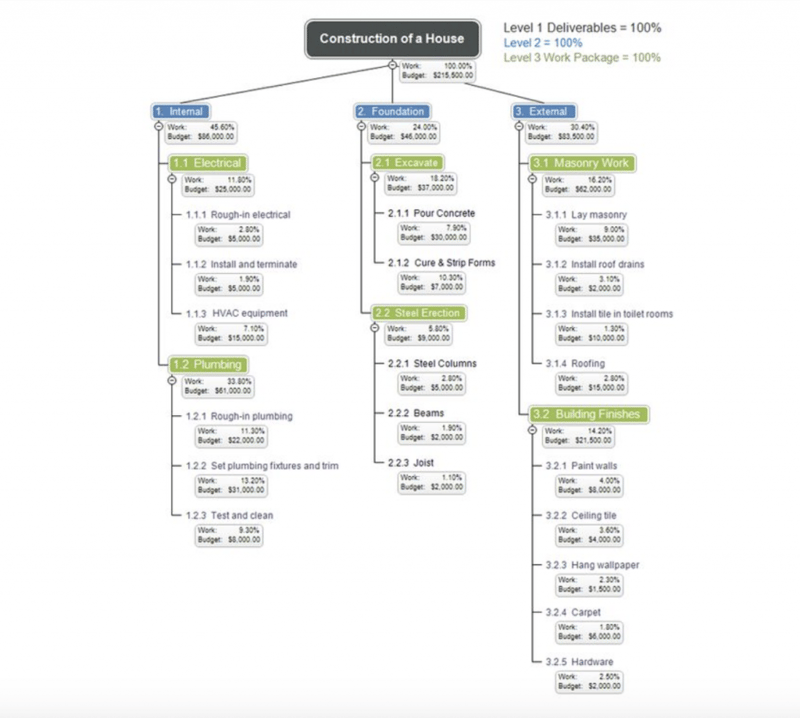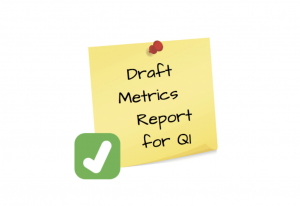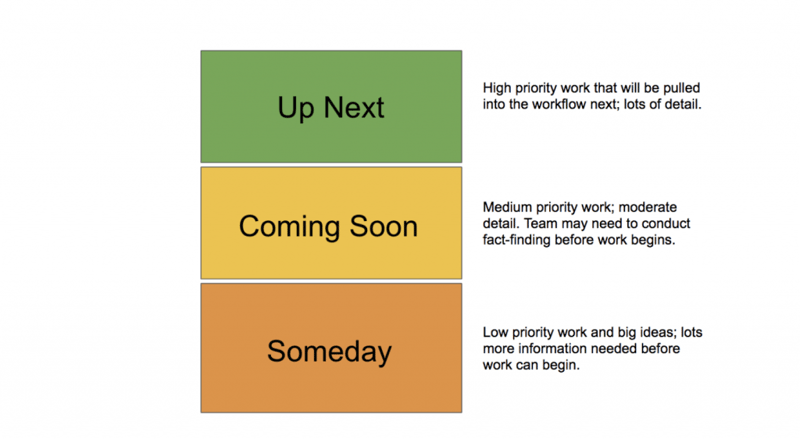When a marketing team receives a new project assignment, the first thing they are likely to receive is the project brief. The always popular “brief” is a short document that (hopefully) describes the end result of the project and its aims. It does provide context. But, it’s by no means an exhaustive account of what the execution team will spend time doing in the coming weeks or months.
As the people closest to the work, it’s now up to the team members to scope out the brief. The team must define what needs to happen, who needs to do it, and how long it will take. Scoping’s main purpose is to give the team an opportunity to figure out the crucial “how” of their assigned “what.”
Of course, the concept of “how” is extremely subjective, especially in large, diverse teams. That’s why, before kicking off work, the team takes time to break down the larger initiative into smaller pieces. So that each smaller piece can have its own manageable steps.
This process is referred to as work breakdown. No matter how big or small your team or project, you’re probably already doing a version of this on a regular basis. But to make it work its hardest, follow these key criteria for a good project breakdown so you can enjoy its multitude of benefits.
Origins of Work Breakdown Structure
In traditional project management, Work Breakdown Structure (WBS) is presented as the decomposition of a large initiative into its more granular deliverables. WBS is so critical that it’s often described as the cornerstone of effective project planning. One of the most popular ways to illustrate WBS is through the construction of a house:

In traditional examples of work breakdown, the team leaders or managers identify, estimate, schedule, and budget before the team starts working. The larger initiative “Construction of a House” gets broken down into its various categories of execution work. In this case - internal, foundation and external.
Then, under these categories, team leads might list various tasks. For example, plumbing and electrical, which both require three further subtasks to be considered complete. Each subtask of the work required is also estimated as a percentage of the total work as well as budget. Other versions of traditional WBS may go into even further detail than this.
Agile WBS
Traditional project and process management methods like the Waterfall model might require your team to put together a WBS at the beginning of Q1 and lock it in. This can result in a lot of unplanned work coming up as work progresses. In some cases, you might also be asked to include details like budget. Maybe even down to the dollar. However, in Agile project management, work breakdown can be a recurring part of your process. It can occur on an as needed or sprint basis, depending on the framework you’re using.
If you’re already practicing Kanban or Scrum, it’s easy to incorporate parts of Agile work breakdown into your regular project planning. In fact, you may already be doing something like it without calling it WBS.
Of course, its name matters much less than doing it as effectively as possible.

Transform Huge Projects Into Actionable Tasks
The act of breaking down humongous, intimidating projects into clear deliverables can have benefits on the team as well as on the individual contributor level if it is done right. Use the following best practices to transform your larger initiatives into truly actionable tasks for the team.
Phrase Tasks As Actions
The #1 WBS tip for Agile projects is to take care that your deliverables are described as actions, not just anchors for ideas. We often see work items in backlogs that look like this:

This provides a minimal amount of information. In fact, it may actually create confusion for the reader. Judging by this card alone, it’s nearly impossible to know what actually needs to be done with the metrics report. Should we put it together? Should we edit it? Distribute it? Make sure that your team’s action items actually describe what needs to get done.

Provide a Clear Definition of Done
Imagine being assigned a task like: “Research Business Agility and Write an Article About It.” You get excited and begin working on it. For the next few days, this might be you…

...but what happens if that’s you for the next month, or two...
Without a definition of done in your deliverables, you might go on working forever on an open-ended task. You might emerge from your desk having read everything ever published about business agility and a 30,000 word paper on the topic when all anybody needed was a 500-word blog post overview. Breaking down projects into truly actionable pieces means including a clear definition of done. The goal is to avoid abstract, never-ending tasks.
Smaller Sessions of Work
Greater visibility about the “chunks” that go into the project at hand also helps team members gain a deeper understanding of the project and their role. This kind of alignment improves team morale, as well as team output.
When work is broken down into bite-sized pieces, team members are enabled to execute in smaller sessions of focused work. They can avoid distractions, instead of always seeking clarification.
In fact, for individual team members, cutting down monster projects into achievable segments clarifies a number of different things, like:
- What is my role in the project?
- How close are we to finishing it?
- What are my teammates working on?
- How does what I’m working on fit into the big picture?
- How can I help others if I finish my task first?
If you can, break down projects up front. It can actually save your team from a lot of miscommunication and friction.
Before proceeding to learn how to increase granularity as priority increases, why don't you take a second to get the most recent State of Agile Marketing Report?
Increase Granularity As Priority Increases
When a team receives a new assignment, it enters an Agile marketing team’s prioritized to-do list of upcoming work. This list of to-dos is also called the backlog. It is then evaluated by the Marketing Owner, who prioritizes the new project against what is already stacked in the backlog. The Marketing Owner’s primary role is making sure the to-do list always reflects the team current priorities based on many internal and external factors.

If the project is low priority, it will be deprioritized in the Coming Soon or Someday sections of the team backlog. These sections of the backlog contain work items thatdo not require a high level of detail at this time. Consequently, this project may not need to be broken down into manageable tasks by the team immediately. However, if the project is high priority, it will get stacked higher in the Up Next section of the backlog. That’s when the team must add further detail to the project by breaking it down into actionable deliverables.
Wondering when to start the Agile work breakdown process? Use priority as your filter. In other words, only break down larger projects into their individual deliverables when they are on deck for the team to work on right now or soon. That way, the team is sure to include the most current information in their decomposition and estimate based on current circumstances.
Make Sure the Items are Similarly Sized
Although it may not matter as much in a Waterfall process, in an Agile system it serves the team well to break down projects into pieces that are similarly sized. For example, when considering the hypothetical rebrand of a product, it would be most effective to break down the larger rebranding project into its individual pieces. Then, add another layer of break down and decompose each of these into deliverables that require similar amounts of effort.

The team members should be in agreement about the size and effort that each deliverable requires. As you learn more about what these deliverables entail, you may choose to break them down even further for greater granularity.
You may choose to break down a “Write New Copy” task into further pieces. Then, you should also break down “Distribute to Markets” and other deliverables into pieces that are of similar size. The effects of having similarly sized deliverables flowing through your Agile process are two-fold, and very important to the productivity of the team.
Reason #1: Process metrics become easier to capture
To gauge the effectiveness of your Agile marketing system, you may be monitoring simple Agile process metrics, such as Throughput, Cycle Time and Efficiency. Unfortunately, all of these become much less useful if you’re dealing with some work items that are huge and others that are tiny.
For example, when measuring throughput, you’re probably measuring your team success by counting up the number of tasks in the Completed section of your Kanban board at the end of the week. But, what happens when the first week, a total of eight work items have been completed and the following week, you count only one work item in Completed? The discrepancy is probably a symptom of differently sized work items rather than your team’s lack of productivity. Yet, it’s going to be hard to make that case to your CMO when s/he comes by to look at the board.
Reason #2: Facilitates Flow In Your Process
Imagine that we left the rebrand project in the example above at the first stage of breakdown. If we’re using a Kanban board, we’ll probably move the Update the Website and New Print Materials tasks into our “In Progress” section. Then they’ll stay there...for months. Work items that big will not move forward in the process because they simply take too much effort and time to execute.
Not having granularity means we see them sitting there, but we have no indication what stage that task is in. Are we close to finishing it? Are we just starting on it? We have zero visibility into how it’s moving along in the process.
Alternatively, smaller bite-sized pieces will steadily move through our Agile process towards complete, one by one. Now, we can observe the slow or fast flow of deliverables through the system. This will give the team an indication of the number of tasks that are To Do, In Progress, or Done. This makes it easy to infer the pace of the team, and how close they are to finishing the project.
Nail Agile Work Breakdown
Getting Agile work breakdown right from the get-go can literally “make” your project experience. Put in the time to figure out all of the actionable pieces of a project and how they fit together. This will bring you exponentially closer to the Holy Grail of high performance: predictable productivity.
If you're not sure where to begin, check out our library of microlearning content based on years of working with Agile marketing teams, and the following 4 learning paths for different contexts:
Each of them contains 10 bite-sized lessons, 20 short engaging videos, and 10+ downloadable resources that can boost your Agile knowledge in minutes even during the busiest days.
Before you move on, don't forget to get the most recent State of Agile Marketing Report.